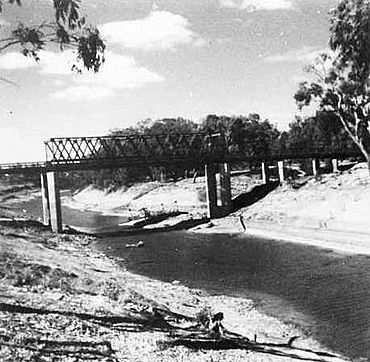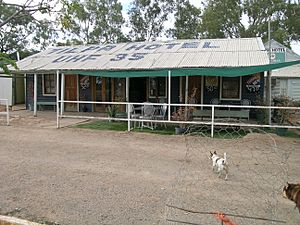Tilpa facts for kids
Quick facts for kids TilpaNew South Wales |
|
|---|---|

The Darling River at Tilpa c. 1945. The punt can be seen behind the new bridge
|
|
| Population | 44 (2016 census) |
| Postcode(s) | 2840 |
| Elevation | 88 m (289 ft) |
| Location |
|
| LGA(s) | Central Darling Shire |
| State electorate(s) | Barwon |
| Federal Division(s) | Farrer |
Tilpa is a small town in the Far West part of New South Wales, Australia. It sits right on the Darling River. Tilpa is about 917 kilometers (570 miles) northwest of Sydney, the state capital.
In 2016, Tilpa and the area around it had 44 people living there. The town itself is very small, with only about nine residents.
The Darling River near Tilpa does not always flow steadily. It can sometimes dry up during long periods without rain. But in 1956, big floods made the river as wide as 80 kilometers (50 miles). This meant Tilpa was cut off from other places for five months.
Tilpa's Past: A River Port
In the past, Tilpa was a very important river port. Large paddle steamers would bring supplies to nearby sheep stations. These stations are big farms where sheep are raised. The steamers would then carry bales of wool back down the river.
The wool traveled to Wentworth. This town is where the Darling River meets the Murray River. From there, the wool went to cities like Adelaide or Echuca. It was then shipped to the port in Melbourne.
Tilpa also had a special punt. This was a flat boat used to move sheep, horses, and people across the Darling River. People had to pay a fee to use it.
In June 1886, Tilpa was described as a "small township on the Darling." It had a good store, a telegraph office, and a large hotel. The town was well-known as a crossing point on the Darling River. This was on the main route between the Paroo district and the Sydney market. A man named Williams owned and ran the punt. He charged 25 shillings for every thousand sheep that crossed.
Today, a bridge has replaced the old punt. The bridge was finished in 1963.
Life and Fun in Tilpa
The local pub, called the Tilpa Hotel, is over 100 years old. It is made from timber and corrugated iron. Inside, the walls are covered with messages and drawings from visitors. People leave these messages in exchange for a donation to the Royal Flying Doctor Service. This service helps people in remote parts of Australia.
Tilpa also has a special memorial from the Second Boer War. This war happened a long time ago in South Africa. The memorial includes a tribute to Breaker Morant. He was a soldier who was put on trial during the war.
The town also says it has Australia's smallest heritage trail. This trail has only two signs, right across the street from each other. Tilpa also claims to have the only cemetery in Australia with no one buried in it!
Tilpa's Economy: Farming and Tourism
Tilpa is mainly a farming area. Raising sheep is the most important activity here. There are also some areas along the river where crops are grown using irrigation.
Tourism is another big part of the local economy. Many people visit to enjoy farmstay programs on local stations. Fishing and camping are also very popular along the river.
In 2007, a long period of dry weather caused Tilpa to run out of clean drinking water. A company from Sydney offered to test a special water cleaning machine. This machine helps make the river and bore water better to drink.



